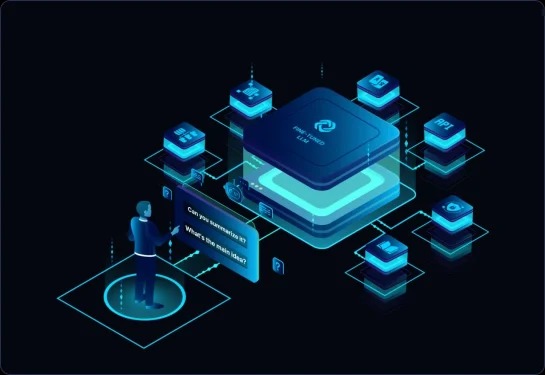Understanding Process Mining Through the Lens of SLM vs LLM: How AI Learns from Business Data

Today, information is omnipresent. Each click, each email, each transaction creates an electronic trace. But how do companies make sense of this constant flow of information? That’s where process mining and machine learning models such as SLMs and LLMs enter into the picture. Together, they allow businesses to see how their systems actually operate, identify what holds them back, and learn to make better decisions.
Let’s divide this into the most basic steps.
What Is Process Mining?
Imagine a company as a large machine with a lot of moving parts: sales, finance, customer service, HR, etc. Each part leaves data as it goes about its business. For instance, when an employee approves a loan or when a customer orders something, that action gets logged somewhere. Now, all these activities create a pattern. But it is not so easy to identify that pattern because the data is dispersed over various systems and files. Process mining makes it easy to connect the dots.
It examines digital traces from business systems and reconstructs the real workflow just as a detective would unravel a case by tracking clues. Through process mining, businesses can observe the way their processes actually occur, not how they believe they occur. They can identify inefficiencies, unnecessary steps, or errors that waste time and money. This is why it is such a strong tool for performance improvement and efficiency enhancement.
How Process Mining Helps AI Learn
AI is based on data to learn. The quality of data determines how intelligent the AI will become. However, not every bit of data can be useful by itself. Most of it is disorganised, unclean, or incomplete.
Process mining cleans and organises the data so that the AI can process it. It displays how business processes run linearly from the beginning to the end. This provides AI with a distinct idea of actual business processes.
Think of process mining as the teacher and AI as the student. The teacher structures classes (data), describes what is occurring, and assists the student (AI) in learning patterns, results, and improved methods of accomplishment.
SLM vs LLM: Two Means AI Learns
When we discuss how AI learns, we tend to hear two significant terms: SLM vs LLM.
- SLM refers to Small Language Model.
- LLM refers to Large Language Model.
Both of them are forms of AI but operate at varying scales.
Let’s know how they are different and how process mining assists both of them.
What Is an LLM (Large Language Model)?
A large language model is a super brain that has been trained on massive amounts of data from books, websites, and online text. It can read human language, give answers to questions, compose essays, summarize reports, and even produce code.
Examples are models such as ChatGPT, Gemini, or Claude. These models are aware of a great deal regarding general matters since they have been trained on an enormous volume of data from the entire world.
But the catch is an LLM does not know much about your business in particular. It may discuss invoices or sales in general but won’t be aware of how your business processes truly function.
Process mining and SLMs fill that gap.
What Is an SLM (Small Language Model)?
An SLM is a specialized version of AI that learns from bespoke, business-oriented data. It gets training from company files, process histories, emails, and transactions, all the in-house data that reflects how a business really operates.
Because it learns from intimate, structured data, an SLM knows company processes better than an LLM. It can respond to questions such as
- Why does this process take longer than normal?
- Where do most of the delays occur?
- What can be automated next?
So, while an LLM is intelligent about general knowledge, an SLM is intelligent about your business.
How Process Mining Bridges SLM and LLM
Process mining becomes the bridge between SLM and LLM. It gathers and structures process data that enables both models to learn better.
Here’s how:
- For LLMs: Process mining offers well-organized data that enables large models to comprehend certain business processes. It cleans up the data and makes it easier to train.
- For SLMs: Process mining offers rich insights from internal processes, providing the model with a comprehensive and correct learning foundation.
Together, when they operate in tandem, organizations can leverage the global knowledge of LLMs and the accurate knowledge of SLMs to make intelligent, data-driven decisions.
A Simple Example
Suppose a bank is looking to minimize delays in loan approval.
- The process mining tool analyzes thousands of loan requests and monitors each step from the moment a customer makes an application to the point of loan approval or rejection.
- It identifies that the maximum delays occur at document verification.
Now, the SLM (learned on this bank’s data) discovers this trend and recommends an internal automation to accelerate document checks. While that happens, the LLM (with its broad base of knowledge) can recommend industry best practices or new AI tools being utilized by other banks. The two together assist the bank in creating a better, faster, and more effective process. That’s the power of process mining, SLM, and LLM combined.
Why Businesses Need Process Mining for AI Training
AI models are as good as the data they are trained on. Process data in most companies is distributed across disparate systems CRM, ERP, HR software, and email. Without process mining, AI systems would learn from incomplete or misleading data.
Here’s why process mining is a must-have:
- It cleans data. It structures dirty process logs and events so AI learns properly.
- It uncovers concealed patterns. AI is able to identify areas for improvement that others might miss.
- It keeps things current. AI is able to update as processes evolve, continuously learning.
- It enhances decision-making. Companies can utilize AI insights to make predictions and plan in advance.
In brief, process mining provides AI with the precise and clear data it requires to become smarter day by day.
The Future: SLM vs LLM Working Together
The argument between SLM vs. LLM is not whether one is superior to the other; it’s about how they can complement each other.
- LLMs bring global intelligence domain knowledge from millions of sources.
- SLMs bring local intelligence understanding of your company’s own systems.
- Process mining brings them together by providing both clean and meaningful data to learn from.
When these three factors are combined, companies can step towards self-improving enterprise systems that not only perform work automatically but also enhance themselves with the passage of time.
Benefits in Real Life
Here’s what businesses get when they put together process mining, SLM, and LLM:
- Quicker operations: less latency, less error.
- Improved customer experience: faster responses and smoother operations.
- Savings: Less manual intervention and wasted resources.
- Intelligent insights: AI models that truly comprehend business context.
- Continuous learning: Systems that learn as data evolves.
These advantages make the integration of process mining and AI a central component of Intelligent Process Automation, facilitating businesses to grow with less effort and greater precision.
Conclusion
In simple terms, process mining enables businesses to understand how their work actually operates. SLMs and LLMs enable them to learn from this knowledge to improve decisions.
- LLMs provide the big picture of what’s occurring in the world.
- SLMs provide the close-up picture of what’s going on inside your company.
- Process mining bridges the two worlds, converting raw data into actual knowledge.
As AI continues to evolve, this bridge between process mining and SLM vs. LLM will define the way businesses will function. It will assist in creating a future when AI not only automates but also actually knows how businesses function and learns to improve them.




